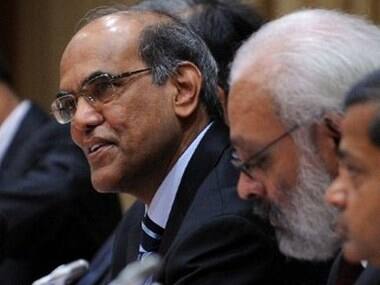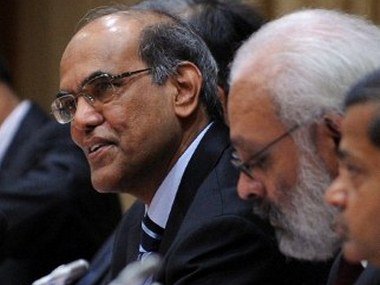By Shanmuganathan Nagasundaram
It’s a widely acknowledged “fact” that Reserve Bank of India Governor D Subbarao is a relatively hawkish central banker. In fact, if we listen to some of our TV news anchors, Indian central bankers are amongst the best in the world.
How then does one explain galloping consumer price increases over the last several years? How does one explain the depreciation of the rupee vis–vis the US dollar as well as a host of other currencies, including the much maligned euro? How does one explain the dramatic decline in the savings rate from 37 percent in 2008 to 30 percent in 2013? And how do these “great” central bankers justify the rapid expansion in money supply over the decades?
The truth is that Indian central bankers are little more than puppets carrying out the wishes of their masters in power, who constantly run up grandiose deficits in the name of public welfare. Their unmindful monetisation of deficits and the subsidisation of government expenditure at the cost of the saving middle class has cost the nation dear - both in terms of growth, wherein the productive private sector would have garnered a greater share of the resources - and consumer price increases would have been much lower.
If Subbarao had actually raised rates a few years back when the signs of out-of-control government expenditures were obvious, our growth today would have been higher and consumer price increases lower. Those conditions are still valid today - if Subbarao doesn’t increase the rates on 17 June then the 5 percent GDP growth that we are seeing today would be the ceiling and not the floor, as the government would like us to believe. The near double-digit consumer price increases would be the floor.
[caption id=“attachment_873625” align=“alignleft” width=“380”] Given slowing growth and rising consumer prices, Subbarao does indeed face a “Volcker moment” today. Would he do what Volcker did? I wish he would though I would put my money on Subbarao doing a Subbarao - that is, continue debasing the rupee.[/caption]
Given slowing growth and rising consumer prices, Subbarao does indeed face a “Volcker moment” today. Would he do what Volcker did? I wish he would though I would put my money on Subbarao doing a Subbarao - that is, continue debasing the rupee.[/caption]
At the heart of this inaction as well as an ostensible conundrum is the belief in Keynesian quackery about the growth-inflation tradeoff. Any Austrian economist (or, for that matter, even our own economists such as Raghuram Rajan) would tell you that growth leads to falling prices and not increasing prices, as we have been led to believe. However, every economic expert in our country, without exception, has stated the opposite over and over again. It actually puzzles me that, guided by people with this level of knowledge, our economy has actually done this well. The answer probably lies in the Deve “Sleeping” Gowda syndrome, where the economy does what it does “despite” the masters and not “because of” them.
While some of our economic think-tank members have woken up to the reality (C Rangarajan indicated a few weeks back that Growth does not warrant inflation , Subbarao still seems to be asleep at the wheel. So the best case scenario would be for Subbarao to not do anything on 17 June.
But can the Indian rupee afford such artificially low interest rates?
As I have explained before, the interest rate is the “price of money”. Given that the demand for money far outpaces the supply of it, it has to imply that we are underpricing interest rates. Also, given that consumer price inflation far outpaces the after-tax returns on savings deposits, citizens are actually doing far more than what can be legitimately expected of them. This situation of negative real interest rates, if allowed to continue for longer periods of time, could have much more debilitating consequences than what we are seeing today.
Leaving alone the effect on the saving community, the need of the hour is for greater resources to be allocated through the “market mechanism” to the private sector, a dramatic downsizing of government expenditure and a move towards sound money to encourage greater savings as well as price stability.
None of the above can be accomplished without higher interest rates. Undoubtedly, some of the bubble/leveraged sectors such as real estate would face a downturn - but the best solution to the problem of mal-investment, as Andrew Mellon put it, is “liquidation”. Supporting mal-investment delays the recovery as the US proved during the Great Depression and as Japan has repeatedly proven over the last 20-plus years.
Not increasing interest rates at this point would lead to lower savings and also to a much greater debasement of the currency in the years ahead. So much lower growth and much higher consumer price increases would be the price we have to pay for the ongoing currency debasement policy. The rupee as well as the Indian economy just cannot afford a Subbarao who dances to his master’s tune.
A Volcker Moment?
I would personally prefer not to have a Central bank at all and have free markets determining the monetary policy based on the quantity/quality of money as well as interest rates. However, given the reality of where we are today, the next best solution is to look up to the best central bankers the world has seen and emulate them.
In my opinion, Paul Volcker has to be the finest central banker to demonstrate how monetary policy has to be run. As Ron Paul would say, “If I had to name a Federal Reserve chairman that did a little bit of good that would be Paul Volcker”. In the face of a severe downturn in the US economy during the late seventies, he had the intellectual fortitude to raise the federal funds rate to “20 percent”.
Given slowing growth and rising consumer prices, Subbarao does indeed face a “Volcker moment” today. Would he do what Volcker did? I wish he would though I would put my money on Subbarao doing a Subbarao - that is, continue debasing the rupee.
Shanmuganathan “Shan” Nagasundaramis the founding director of Benchmark Advisory Services - an economic consulting firm. He is also the India Economist for the World Money Analyst, a monthly publication of International Man. He can be contacted at shanmuganathan.sundaram@gmail.com
)